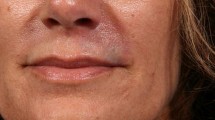Abstract
For deep glabellar and nasolabial folds as well as cheek and chin augmentation, our preferred filler is Radiesse®, which is calcium hydroxylapatite gel. Radiesse® has proven to be an excellent dermal filler for severe folds, wrinkles that require large volumes and respond well to deep placement. Suitable areas include the nasolabial, melolabial, and glabellar area folds. It is recommended to inject below the dermis to avoid visibly noticeable lumps and irregularities. For the nasolabial folds, inject slightly inferomedial to each nasolabial fold as the area of least likelihood for migration. The natural muscular action of the facial muscles will tend to lateralize the effect and can worsen the appearance if not placed slightly inferomedially.
Access provided by Autonomous University of Puebla. Download chapter PDF
Similar content being viewed by others
Keywords
For deep glabellar and nasolabial folds as well as cheek and chin augmentation, our preferred filler is Radiesse®, which is calcium hydroxylapatite gel. Radiesse® has proven to be an excellent dermal filler for severe folds, wrinkles that require large volumes and respond well to deep placement. Suitable areas include the nasolabial, melolabial, and glabellar area folds. It is recommended to inject below the dermis to avoid visibly noticeable lumps and irregularities. For the nasolabial folds, inject slightly inferomedial to each nasolabial fold as the area of least likelihood for migration. The natural muscular action of the facial muscles will tend to lateralize the effect and can worsen the appearance if not placed slightly inferomedially.
Prior to injection, the target sites should first be cleaned with alcohol wipes followed by Betadine as this is a semipermanent filler. The authors have personally seen no infections with Radiesse®, but there is risk for a very potentially difficult to treat biofilm-type infection. We advise injecting with a blunt-tipped cannula (22–27 gauge with exit port facing up) to minimize the risk of necrosis or visual complications from intravascular injection (Fig. 144.1) (Kim et al. 2011). Utilizing a sterile 21 g needle to create an entry site works well to allow for easy entry of the blunt cannula into the skin. Radiesse® is a thick consistency filler, which is more easily and comfortably injected if diluted with 0.25–0.33 cc of 1 % lidocaine hydrochloride plain in the 1.5 cc syringe. A syringe connector is provided with each package for this purpose. Since initiating this lidocaine dilution technique, nerve blocks have become unnecessary, and injection comfort and bruising have been improved over needle injections. Small amounts of plain 1 % lidocaine hydrochloride can be placed at needle injection sites for more sensitive patients. Cooling of the skin is also useful to decrease discomfort. A linear threading or fanning technique can be used to achieve linear filling or volumization.
A single syringe (1.5 cc) of Radiesse® is adequate for most nasolabial folds. Some patients desire or require a second syringe at a later time to achieve an optimal result. In the glabellar areas a quarter to half a syringe is all that is required (Fig. 144.2). Patients should be cautioned, and placement must be precise in the glabellar region as necrosis (Fig. 144.3), and visual loss has been reported from intravascular injection of fillers (Georgescu et al. 2009). In general, glabellar fold injections are not uncomfortable, and we do not inject local anesthetic, which distorts the target area. Special care should be taken to avoid intra-arterial injections in this area.
Radiesse® is not advisable for lip augmentation, as the patients often complain of lumps and irregularities. Caution must be exercised to avoid injecting Radiesse® too superficially, which can cause skin necrosis. For visible lumps, immediate massage and/or needling (e.g., 18–21 g) may be performed. We have found Radiesse® to give improvement for the reported 2 years in most of our patients and is our present choice for deep fillers.
References
Georgescu D, Jones Y, McCann JD, Anderson RL. Skin necrosis after calcium hydroxylapatite injection into the glabellar and nasolabial folds. Ophthal Plast Reconstr Surg. 2009;25(6):498–9.
Kim YJ, Kim SS, Song WK, Lee SY, Yoon JS. Ocular ischemia with hypotony after injection of hyaluronic acid gel. Ophthal Plast Reconstr Surg. 2011;27:152–5.
Author information
Authors and Affiliations
Corresponding author
Editor information
Editors and Affiliations
Rights and permissions
Copyright information
© 2015 Springer Science+Business Media New York
About this chapter
Cite this chapter
Burroughs, J.R., Anderson, R.L. (2015). Radiesse® Pearls: General Tips for Safer, More Comfortable, and Better Results. In: Hartstein, MD, FACS, M., Massry, MD, FACS, G., Holds, MD, FACS, J. (eds) Pearls and Pitfalls in Cosmetic Oculoplastic Surgery. Springer, New York, NY. https://doi.org/10.1007/978-1-4939-1544-6_144
Download citation
DOI: https://doi.org/10.1007/978-1-4939-1544-6_144
Published:
Publisher Name: Springer, New York, NY
Print ISBN: 978-1-4939-1543-9
Online ISBN: 978-1-4939-1544-6
eBook Packages: MedicineMedicine (R0)







